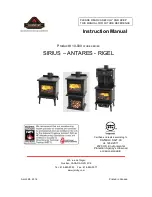
-10-
Operating Instructions
CAUTIONS: HOUSE FIRE HAZARDS
•
Do not store wood on floor protector, underneath stovepipe(s) if applicable, or anywhere within clearances
to combustible surfaces specified for this appliance.
•
Never operate with secondary tubes, fiber board, or insulation removed.
OPERATING SAFETY PRECAUTIONS
•
Never overfire this appliance by building excessively hot fires as a house/building fire may result. You are
overfiring the appliance if it begins to glow or turn red.
•
Never build excessively large fires in this type of appliance as damage to the firebox or smoke leakage may
result.
•
Do not build fire too close to glass.
•
Hot while in operation. Keep children, clothing, and furniture away. Contact may cause skins burns. Do not
touch the appliance until it has cooled.
•
Provide adequate air for combustion to the room where the appliance is installed.
•
Inspect chimney liner every 60 days. Replace liner immediately if it is rusting or leaking smoke into the room.
•
Attempts to achieve heat output rates that exceed heater design specifications can result in permanent
damage to the heater.
WARNING: EXPLOSION HAZARD
•
Never use chemicals, gasoline, gasoline-type lantern fuel, kerosene, charcoal lighter fluid, or similar
flammable liquids to start or “freshen up” a fire in the appliance.
•
Keep all flammable liquids, especially gasoline, out of the vicinity of the appliance - whether in use or in
storage.
THIS APPLIANCE IS DESIGNED TO BURN NATURAL WOOD FUEL ONLY!
Hardwood, 17” to 19”, should be split and air dried (seasoned) for 6 months to obtain maximum burning efficiency.
Wood should be stored in a dry, well ventilated area. Burning fuels other than intended, chemicals, or waste
in this appliance could result in damages to the heater or result in bodily injury. It will also void any warranty
on the appliance. This heater is designed to burn natural wood only. Higher efficiencies and lower emissions
generally result when burning air dried seasoned hardwoods, as compared to softwoods or to green or freshly
cut hardwoods.
DO NOT BURN:
1. Garbage;
2. Lawn clippings or yard waste;
3. Materials containing rubber, including tires;
4. Materials containing plastic;
5. Waste petroleum products, paints or paint thinners,
or asphalt products;
6. Materials containing asbestos;
7. Construction or demolition debris;
8. Railroad ties or pressure-treated wood;
9. Manure or animal remains;
10. Salt water driftwood or other previously salt water
saturated materials;
11. Unseasoned wood; or
12. Paper products, cardboard, plywood, or
particleboard. The prohibition against burning these
materials does not prohibit the use of fire starters
made from paper, cardboard, saw dust, wax and
similar substances for the purpose of starting a fire in
an affected wood heater.
Burning these materials may result in release of toxic fumes or render the heater ineffective and cause smoke.
Dead wood lying on the forest floor should be considered wet, and requires full seasoning time. Standing dead
wood can usually be considered to be about 2/3 seasoned. Splitting and stacking wood before it is stored
accelerates drying time. Storing wood on an elevated surface from the ground and under a cover or covered
area from rain or snow also accelerates drying time. A good indicator if wood is ready to burn is to check the
piece ends. If there are cracks radiating in all directions from the center then the wood should be dry enough
to burn. If your wood sizzles in the fire, even though the surface is dry, it may not be fully cured, and should be
seasoned longer.
Содержание VOGELZANG VG1820
Страница 19: ...19 Notes...











































